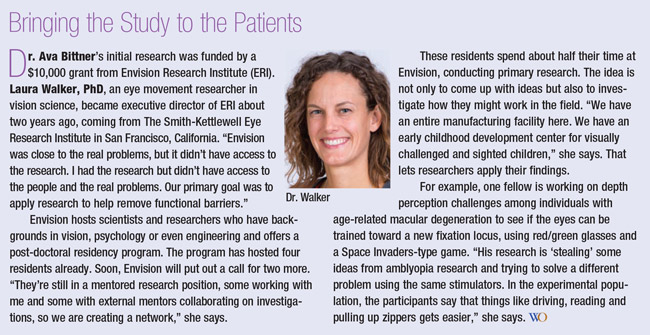

The germ of an idea that sprouted four years ago at a summer research institute sponsored jointly by the American Optometric Association and the American Academy of Optometry is now a pilot study—and could, one day, be even more. At that meeting, Ava Bittner, OD, PhD, FAAO (Dipl.), from Nova Southeastern College of Optometry, and Amy Nau, OD, FAAO, who was using telerehabilitation in research involving totally blind patients, came up with the idea of a pilot study to conduct follow-up visits through telemedicine for low vision patients who receive a magnification device for reading. “Three years later, we collaborated on grant proposals, but we had little more than the idea and yet we had maintained our passion to pursue this study,” Dr. Bittner says. However, their pilot study was recently funded with a $10,000 grant from Envision Research Institute. (See story below.) “That will allow us to get pilot data so that we can apply for larger grants.” Dr. Nau is on the team as a consultant.
“A major challenge and barrier for low vision rehabilitation providers is transportation for the patients. Providers can dispense a magnifier and encourage the patient to come back, but those return visits are challenging. We wanted to see if videoconferencing with patients in their home situation allowed us to provide better feedback and guidance,” she says. There are technical hurdles to overcome: do patients in remote communities have the connectivity to participate and are providers able to use a videoconferencing portal to evaluate the patient’s reading ability? Different collaborators began working on the study—some to find the ideal hardware and software combination and others trying to identify commercially available videoconference portals that are HIPAA compliant, as well as loaner equipment that could be placed in the homes of patients who had no internet-connected cameras and computers.
Dr. Bittner presented her findings at the 2016 Envision conference held in Denver, Colorado, in September. “I’m really passionate about trying to pursue this. It’s an ambitious project, and we’re also developing the prototype of the system and the components,” she says. She’s grateful for the grant she received. “The beauty of having a little money or support is that we can collect some data for a larger grant. We can show feasibility and potential for success.” Dr. Bittner’s own interest in low vision took hold when she was a fourth-year optometry school student. “The patients’ reactions to being able to improve their visual functioning with magnifiers and assistive devices were unlike anything else I experienced,” she recalls. “Sometimes even the most basic intervention can transform their ability to read and complete daily activities.”
Many ODs could provide low vision services to people with early vision loss easily, she says. “Patients with vision better than 20/70, for example, could be managed without referral by prescribing high add power in eyeglasses with a good reading light and/or an illuminated low-power handheld magnifier,” she says. “There are simple strategies that can make your patients with minimally reduced vision very happy, such as when applied to a 96-year-old patient with early age-related macular degeneration who can be corrected to 20/25 but complains of being unable to read the newspaper. This is a growing segment of our population who can be helped by any OD. We hope that one day telerehabilitation can be useful to help follow up with these patients to determine if the intervention was successful to meet the patient’s reading needs in their home environment.”





